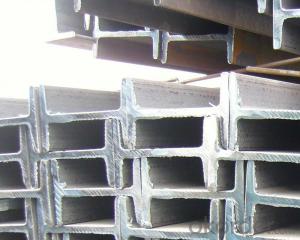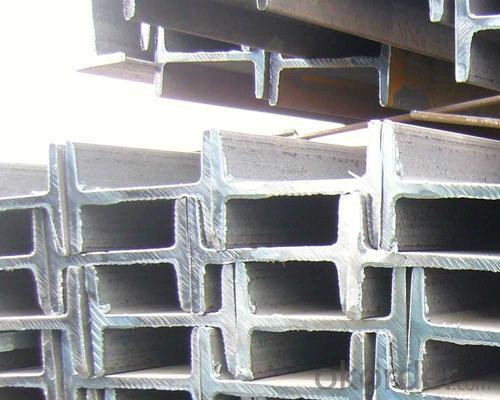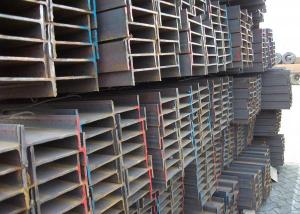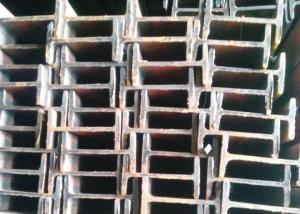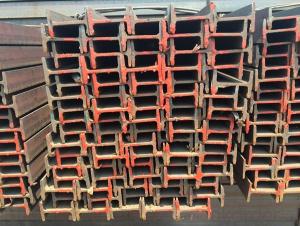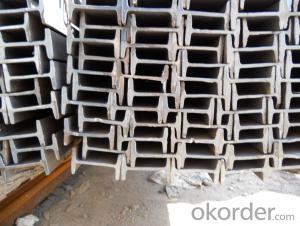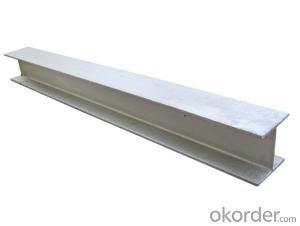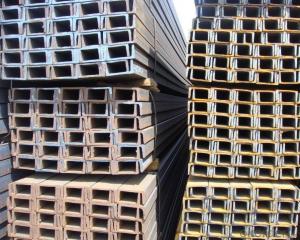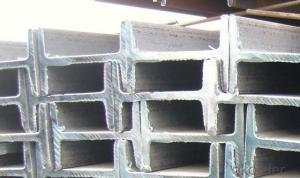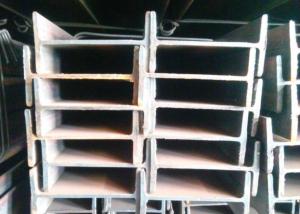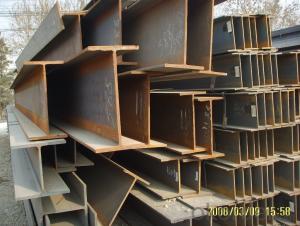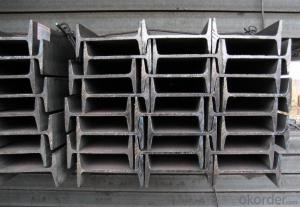Carbon stainless steel I-Beam for construction
- Loading Port:
- Tianjin
- Payment Terms:
- TT or LC
- Min Order Qty:
- 25 m.t.
- Supply Capability:
- 100000 m.t./month
OKorder Service Pledge
OKorder Financial Service
You Might Also Like
Product Description:
OKorder is offering carbon stainless steel I-Beam for construction at great prices with worldwide shipping. Our supplier is a world-class manufacturer of steel, with our products utilized the world over. OKorder annually supplies products to European, North American and Asian markets. We provide quotations within 24 hours of receiving an inquiry and guarantee competitive prices.
Product Applications:
Carbon stainless steel I-Beam are ideal for structural applications and are widely used in the construction of buildings and bridges, and the manufacturing, petrochemical, and transportation industries.
Product Advantages:
OKorder's steel I-Beam are durable, strong, and resist corrosion.
Main Product Features:
· Premium quality
· Prompt delivery & seaworthy packing (30 days after receiving deposit)
· Corrosion resistance
· Can be recycled and reused
· Mill test certification
· Professional Service
· Competitive pricing
Product Specifications:
Specifications of Hot Rolled H-Beam Steel
1. Standard: JIS G3101
2. Grade: SS400 or Equivalent
3. Length: 6m,10m, 12m as following table
4. Invoicing on theoretical weight or actual weight as customer request
5.Payment: TT or L/C
6. Sizes:
SIZE(mm) | DIMENSION(kg/m) |
100*100 | 16.9 |
125*125 | 23.6 |
150*75 | 14 |
150*150 | 31.1 |
148*100 | 20.7 |
198*99 | 17.8 |
200*100 | 20.9 |
248*124 | 25.1 |
250*125 | 29 |
300*150 | 36.7 |
298*149 | 32 |
200*200 | 49.9 |
294*200 | 55.8 |
346*174 | 41.2 |
350*175 | 49.4 |
244*175 | 43.6 |
175*175 | 40.4 |
294*200 | 55.8 |
298*201 | 64.4 |
346*174 | 41.2 |
350*175 | 49.4 |
400*200 | 65.4 |
396*199 | 56.1 |
450*200 | 74.9 |
446*199 | 65.1 |
340*250 | 78.1 |
500*200 | 88.1 |
300*150 | 36.7 |
Usage & Applications of Hot Rolled H-Beam Steel
Commercial building structure ;Pre-engineered buildings; Machinery support structure; Prefabricated structure; Medium scale bridges; Ship-building structure. etc.
Packaging & Delivery of Hot Rolled H-Beam Steel
1. Packing: it is nude packed in bundles by steel wire rod
2. Bundle weight: not more than 3.5MT for bulk vessel; less than 3 MT for container load
3. Marks:
Color marking: There will be color marking on both end of the bundle for the cargo delivered by bulk vessel. That makes it easily to distinguish at the destination port.
Tag mark: there will be tag mark tied up on the bundles. The information usually including supplier logo and name, product name, made in China, shipping marks and other information request by the customer.
If loading by container the marking is not needed, but we will prepare it as customer request.
4. Transportation: the goods are delivered by truck from mill to loading port, the maximum quantity can be loaded is around 40MTs by each truck. If the order quantity cannot reach the full truck loaded, the transportation cost per ton will be little higher than full load.
5. Delivered by container or bulk vessel
Production flow of Hot Rolled H-Beam Steel
Material prepare (billet) —heat up—rough rolling—precision rolling—cooling—packing—storage and transportation
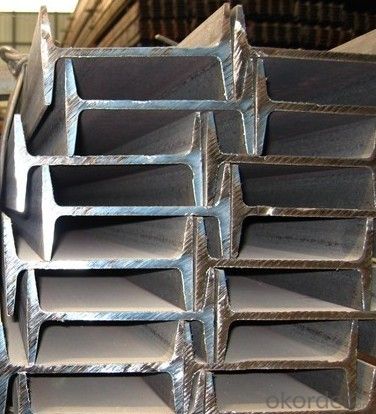
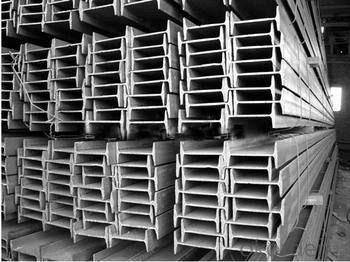
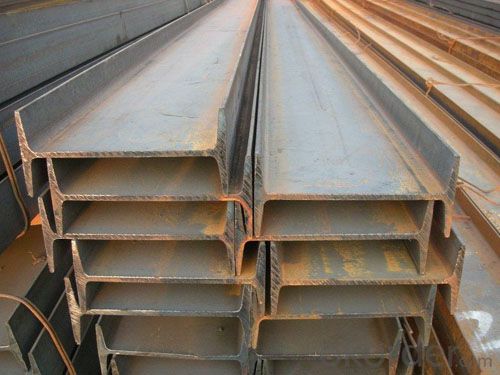
FAQ:
Q1: Why buy Materials & Equipment from OKorder.com?
A1: All products offered byOKorder.com are carefully selected from China's most reliable manufacturing enterprises. Through its ISO certifications, OKorder.com adheres to the highest standards and a commitment to supply chain safety and customer satisfaction.
Q2: How do we guarantee the quality of our products?
A2: We have established an advanced quality management system which conducts strict quality tests at every step, from raw materials to the final product. At the same time, we provide extensive follow-up service assurances as required.
- Q: Can steel I-beams be used for residential construction?
- Yes, steel I-beams can be used for residential construction. They are commonly used as structural support elements in building frames, especially for larger or more complex residential structures where additional strength and load-bearing capacity is required. Steel I-beams offer several advantages, such as high strength-to-weight ratio, durability, and versatility in design.
- Q: Can steel I-beams be used in the construction of healthcare facilities?
- Yes, steel I-beams can be used in the construction of healthcare facilities. Steel I-beams are commonly used in the construction industry due to their strength, durability, and versatility. They are capable of supporting heavy loads and providing structural integrity to buildings. In healthcare facilities, where the safety and well-being of patients are of utmost importance, the use of steel I-beams can ensure a strong and secure structure. They can be used in various applications such as supporting the roof, creating open spaces, and providing support for equipment and utilities. Moreover, steel I-beams can be easily fabricated and installed, offering flexibility in the design and construction process of healthcare facilities. Additionally, steel is a non-combustible material, which enhances the fire safety of the building. Overall, steel I-beams are a suitable choice for constructing healthcare facilities, providing a reliable and durable structural framework.
- Q: Are steel I-beams suitable for high-rise building construction?
- Steel I-beams are an excellent choice for constructing high-rise buildings. They have been widely used in the construction industry for many years because of their numerous advantages. To begin with, steel I-beams have a remarkable strength-to-weight ratio, which makes them perfect for tall structures. They can support heavy loads and provide exceptional structural support, which is vital for high-rise buildings. This strength allows for the construction of taller and more spacious buildings without compromising their structural integrity. Furthermore, steel I-beams are extremely durable and resistant to various environmental factors. They can withstand extreme weather conditions, seismic activities, and even fires. This durability ensures the longevity and safety of high-rise buildings, providing a secure living or working environment for occupants. In addition, steel I-beams are versatile and allow for flexible design options. They can be customized to meet specific architectural requirements and building codes. This flexibility enables architects and engineers to create innovative and aesthetically pleasing high-rise structures. Moreover, the use of steel I-beams in high-rise construction allows for faster and more efficient construction processes. Steel is readily available, and the prefabricated nature of I-beams makes them easy to transport and assemble on-site. This reduces construction time and costs, making it an attractive option for building owners. Lastly, steel I-beams are sustainable and environmentally friendly. Steel is a highly recyclable material, and using it in construction helps reduce the demand for new raw materials. Additionally, steel structures can be dismantled and recycled at the end of their lifespan, minimizing waste and environmental impact. In conclusion, steel I-beams are highly suitable for high-rise building construction due to their exceptional strength, durability, versatility, efficiency, and sustainability. They have proven to be a reliable and cost-effective choice for creating tall and safe structures, making them a preferred option in the construction industry.
- Q: Are there any safety considerations when working with steel I-beams?
- Working with steel I-beams entails multiple safety considerations. First and foremost, it is crucial to provide adequate training to all workers involved in the installation, handling, and assembly of these beams. They must have a clear understanding of safety protocols, be well-versed in proper lifting techniques, know how to correctly use personal protective equipment (PPE), and be aware of the potential hazards associated with working with heavy materials. One significant risk when working with steel I-beams is the possibility of falls and injuries resulting from working at elevated heights. To prevent accidents, it is important to implement and utilize appropriate fall protection measures such as guardrails, safety harnesses, and safety nets. Additionally, workers should exercise caution on slippery or uneven surfaces that can increase the risk of falls. Another safety consideration is the weight and size of the steel I-beams. These beams can be extremely heavy and require specialized equipment like cranes or forklifts for lifting and positioning. It is crucial to ensure that the equipment used is suitable for the task and does not exceed the load-bearing capacity. Overloading or improper use of lifting equipment can lead to accidents, injuries, or even fatalities. Fire safety is also a vital aspect to be mindful of when working with steel I-beams. Due to steel's ability to conduct heat, it can quickly become hot and lose its structural integrity in case of a fire. Consequently, measures such as fire-resistant coatings or fire suppression systems should be implemented to minimize the risk of fire and protect the structural integrity of the beams. Lastly, it is essential to assess the structural stability of the steel I-beams and ensure proper support during installation and use. Any signs of corrosion, damage, or structural weakness should be thoroughly inspected and addressed before commencing any work involving the beams. In summary, working with steel I-beams necessitates meticulous planning, adherence to safety protocols, and adequate training to mitigate various risks and ensure the safety of workers.
- Q: Can steel I-beams be used as columns or posts in construction?
- Yes, steel I-beams can be used as columns or posts in construction. Steel I-beams are widely used in construction due to their high strength and load-bearing capabilities. They are commonly used as columns or posts to support heavy loads and provide structural stability. Steel I-beams are known for their durability and resistance to bending or warping, making them suitable for use in various types of construction projects. Additionally, steel I-beams can be easily customized to meet specific design requirements and can be fabricated in various sizes and lengths.
- Q: Can Steel I-Beams be used for mezzanine storage?
- Yes, Steel I-Beams can be used for mezzanine storage. They are commonly used in construction for their strength and load-bearing capabilities, making them suitable for supporting elevated storage platforms like mezzanines.
- Q: Can Steel I-Beams be used for power plants?
- Indeed, steel I-beams are suitable for power plants. These beams are widely utilized in construction due to their exceptional structural strength and ability to bear heavy loads. In power plants, where the presence of heavy machinery and equipment is inevitable, steel I-beams offer the essential support and stability required. Their utility extends to numerous applications within power plants, such as providing support for turbines, generators, boilers, and other vital components. Furthermore, steel I-beams exhibit exceptional heat resistance, enabling them to endure high temperatures, which renders them highly suitable for power plants engaged in thermal energy generation.
- Q: What are the different types of steel finishes available for I-beams?
- There are several types of steel finishes available for I-beams, including hot-rolled, cold-rolled, galvanized, and painted finishes.
- Q: Are steel I-beams resistant to rot or decay?
- No, steel I-beams are not resistant to rot or decay. Unlike wood, steel does not absorb moisture, which means it is not susceptible to rotting or decaying. Steel I-beams are often used in construction projects precisely because of their durability and resistance to environmental factors. They are designed to withstand heavy loads and resist corrosion, making them a long-lasting and reliable choice for structural support.
- Q: How much weight can I hold for No. 30 I-beam?
- This is a steel structure, safe bearing capacity of steel structure, it is important to combine different components, structure and computing node is very important, not only to see the I-beam girders, columns, joints and foundation are very important. Take the landlord used 108 * 4 steel, the section is estimated to be less than 1257mm -, 215N/mm - axial compressive strength design value, the stability coefficient estimates of less than 0.5, and the eccentricity is not considered, a preliminary estimate of each pipe under the load calculated only ten tons, and then divided by partition coefficient of load!
Send your message to us
Carbon stainless steel I-Beam for construction
- Loading Port:
- Tianjin
- Payment Terms:
- TT or LC
- Min Order Qty:
- 25 m.t.
- Supply Capability:
- 100000 m.t./month
OKorder Service Pledge
OKorder Financial Service
Similar products
Hot products
Hot Searches
Related keywords
